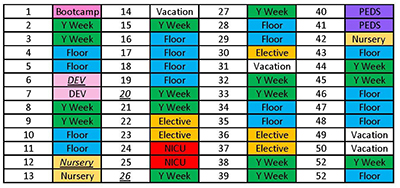X + Y Scheduling
In 2017, our program initiated an exciting change in our resident scheduling model called X+Y scheduling. Instead of a typical 4-week rotation with one half day of continuity clinic interspersed each week, we made an innovative change to the method in which we deliver education, training, and clinical care. The structure of X + Y scheduling allows our residents to spend focused, uninterrupted time in both the inpatient and outpatient setting throughout the academic year.
In our new model, the core inpatient rotations (general pediatric floor, ICU, electives) occur in the 2-4 week blocks and are followed by 2 "Y" weeks. During these "Y" weeks, residents have a mixture of their own primary continuity clinic, ambulatory elective time, other educational experiences and longitudinal curricula.
The X + Y schedule allows residents time to focus completely on the rotation experience in which they are participating. On inpatient units and subspecialty electives, the residents are present throughout the day for teaching, patient follow up and transitions of care. This also allows for a significant decrease in the number of patient handoffs and cross-coverage of patients between team members. Less handoffs means less opportunity for error due to missed information and, in turn, increased patient safety.
On the "Y" weeks, residents learn outpatient medicine in a focused manner. They are able to see ill patients for follow-up within the same week, which was previously much more difficult. Additionally, the 2 week "Y" block schedule also lends itself well to continuity well-visits, both yearly and for the monthly visits of infants and toddlers. As an added bonus, the "Y" week schedule allows for a bit of recuperation after longer hours during the "X" week blocks. As we see more and more medicine practiced in the outpatient setting, a solidified, consistent outpatient experience is crucial to education for future specialists as well as generalists.


